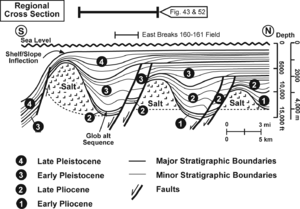Difference between revisions of "East Breaks reservoir rock"
Cwhitehurst (talk | contribs) |
|||
| Line 18: | Line 18: | ||
==''Glob alt'' sequence deposition== | ==''Glob alt'' sequence deposition== | ||
| − | [[File:Sedimentary-basin-analysis fig4-44.png|thumbnail | + | [[File:Sedimentary-basin-analysis fig4-44.png|thumbnail|{{figure number|1}}See text for explanation.]] |
[[file:sedimentary-basin-analysis_fig4-47.png|thumb|{{figure number|2}}After Armentrout et al.<ref name=ArmentroutEtAl_1991>Armentrout, J. M., S. J. Malacek, P. Braithwaite, and C. R. Beeman, 1991, Seismic facies of slope basin turbidite reservoirs, East Breaks 160-161 field: Pliocene-Pleistocene, northwestern Gulf of Mexico, ''in'' P. Weimer and M. J. Link, eds., Seismic facies and sedimentary processes of submarine fans and turbidite systems: New York, Springer-Verlag, p. 223-239. /> Courtesy Springer-Verlag.]] | [[file:sedimentary-basin-analysis_fig4-47.png|thumb|{{figure number|2}}After Armentrout et al.<ref name=ArmentroutEtAl_1991>Armentrout, J. M., S. J. Malacek, P. Braithwaite, and C. R. Beeman, 1991, Seismic facies of slope basin turbidite reservoirs, East Breaks 160-161 field: Pliocene-Pleistocene, northwestern Gulf of Mexico, ''in'' P. Weimer and M. J. Link, eds., Seismic facies and sedimentary processes of submarine fans and turbidite systems: New York, Springer-Verlag, p. 223-239. /> Courtesy Springer-Verlag.]] | ||
Revision as of 18:55, 13 March 2014
| Exploring for Oil and Gas Traps | |

| |
| Series | Treatise in Petroleum Geology |
|---|---|
| Part | Critical elements of the petroleum system |
| Chapter | Sedimentary basin analysis |
| Author | John M. Armentrout |
| Link | Web page |
| Store | AAPG Store |
Four reservoir intervals are productive in the East Breaks 160-161 minibasin: Glob alt, Glob M, Hyal B, and Trim A horizons. Reservoir intervals are named for the regionally useful bioevent species stratigraphically above the reservoir. These bioevents most often occur within condensed sections. All four reservoir intervals are interpreted to be gravity-flow sand deposits.[1] Only the Glob alt reservoir is considered here.
Glob alt sequence deposition
[[file:sedimentary-basin-analysis_fig4-47.png|thumb|Figure 2 After Armentrout et al.Cite error: Closing </ref> missing for <ref> tag Mass-wasting processes occurred on the slope well to the north of the field, as shown by slump facies on Figure 4-39. The areal extent of the basin-floor sheet is restricted by the areal extent of the East Breaks 160-161 intraslope minibasin.
Accommodation space
Differential loading of the mobile salt resulted in some syndepositional subsidence and accommodation of the Glob alt sand-prone isochron thick. The apparent thickening into the north-bounding growth fault is due to the maximum differential subsidence and isochron thickening being coincident with the fault trace of a much younger growth fault phase. Biostratigraphic calibration of the fault system indicates most, if not all, of the fault offset occurred during middle Pleistocene time, after the Trifarina rutila bioevent (= Ang B) dated at 1.30 Ma (Figure 4-31). This is more than length::1.5 m.y. after deposition of the Glob alt sands.
Structural trap formation
Structural trap formation is related to differential rotation of the Glob alt sand-prone interval. This rotation occurred between 1.3 Ma and the present. The result was the development of the rollover anticline downthrown to fault A′, which is a splay off regional fault A (Figures 4-42 and 4-43). (See[2], [3], [4], and Weimer and Bouma, 1995, for discussions on structural control of deepwater deposition.)
See also
- East Breaks petroleum system
- East Breaks seal rock
- East Breaks overburden rock
- East Breaks source rock
References
- ↑ Armentrout, J. M., 1991, Paleontological constraints on depositional modeling: examples of integration of biostratigraphy and seismic stratigraphy, Pliocene–Pleistocene, Gulf of Mexico, in Weimer, P., Link, M., H., eds., Seismic Facies and Sedimentary Processes of Submarine Fans and Turbidite Systems: New York, Springer-Verlag, p. 137–170.
- ↑ Apps, G. M., F. J. Peel, C. J. Travis, and C. A. Yeilding, 1994, Structural controls on Tertiary deep water deposition in the northern Gulf of Mexico: Proceedings, Gulf Coast Section SEPM 15th Annual Research conference, p. 1–7.
- ↑ Armentrout, J. M., 1996, High-resolution sequence biostratigraphy: examples from the Gulf of Mexico Plio–Pleistocene, in Howell, J., and J. Aiken, eds., High Resolution Sequence stratigraphy: Innovations and Applications: The Geological Society of London Special Publication 104, p. 65–86.
- ↑ Cite error: Invalid
<ref>tag; no text was provided for refs namedch04r53
